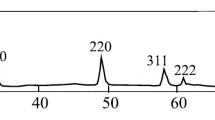Abstract
The heat capacity of GdVO4 has been determined by adiabatic calorimetry in the range 5–345 K. The present experimental data and earlier results have been used to evaluate the thermodynamic functions of gadolinium orthovanadate (C 0 p (T), S 0(T), H 0(T) − H 0(0), and Φ0(T)) as functions of temperature (5–350 K). Its Gibbs energy of formation is determined to be Δf G 0(GdVO4, 298.15 K) = −1684.5 ± 1.6 kJ/mol.
Similar content being viewed by others
References
Bondar’, I.A., Vinogradova, N.V., Dem’yanets, L.N., et al., Soedineniya redkozemel’nykh elementov: Silikaty, germanaty, fosfaty, arsenaty, vanadaty (Rare-Earth Compounds: Silicates, Germanates, Phosphates, Arsenates, and Vanadates), Moscow: Nauka, 1983.
Sirota, N.N., Novikov, A.V., Novikova, V.V., and Novikov, V.V., Heat Capacity and Thermodynamic Functions of the RVO4 (R = Pr, Nd, Sm, Eu, Gd, Tb) Orthovanadates from 5 to 300 K, Zh. Fiz. Khim., 1990, vol. 64, no. 7, pp. 1750–1755.
Dorogova, M., Navrotsky, A., and Boatner, L.A., Enthalpy of Formation of Rare Earth Orthovanadates REVO4, J. Solid State Chem., 2007, vol. 180, p. 847.
Westrum, E.F., Jr., Schottky Contributions in Chemical Thermodynamics, J. Therm. Anal., 1985, vol. 30, pp. 1209–1215.
Milligan, W.O. and Vernon, L.W., Crystal Structure of Heavy Metal Orthovanadates, J. Phys. Chem., 1952, vol. 56, pp. 145–147.
Naumov, V.A., X-Ray Diffraction Study of Scandium, Yttrium, Cerium, Neodymium, and Gadolinium Orthovanadates, Zh. Strukt. Khim., 1962, vol. 3, no. 5, p. 608.
Brusset, H., Madaule-Aubry, F., Blanck, B., et al., Etude des oxides mixte de lanthanides et de vanadium(V), Can. J. Chem., 1971, vol. 49, pp. 3700–3707.
Malyshev, V.V., Mil’ner, G.A., Sorkin, E.L., and Shibakin, V.F., Automatic Low-Temperature Calorimeter, Prib. Tekh. Eksp., 1985, no. 6, pp. 195–197.
Gurevich, V.M., Kuskov, O.L., Gavrichev, K.S., and Tyurin, A.V., Heat Capacity and Thermodynamic Functions of Epsomite, MgSO4 · 7H2O, in the Range 0–303 K, Geochem. Int., 2007, vol. 45, no. 2, pp. 206–209.
Gurevich, V.M., Gorbunov, V.E., Gavrichev, K.S., and Khodakovskii, I.L., Calorimeter for Heat Capacity Measurements from 50 to 300 K and the Low-Temperature Heat Capacity of Kogarkoite, Na3SO4F(cr), Geochem. Int., 1999, vol. 37, no. 4, pp. 367–377.
Gurevich, V.M., Gavrichev, K.S., Gorbunov, V.E., et al., Low-Temperature Heat Capacity of Strontianite, SrCO3(cr), Geochem. Int., 2001, vol. 39, no. 7, pp. 676–682.
Termicheskie konstanty veshchestv: Spravochnik (Thermal Constants of Substances: A Handbook), Glushko, V.P., Ed., Moscow: 1965–1982. http://www.chem.msu.ru
Author information
Authors and Affiliations
Corresponding author
Additional information
Original Russian Text © K.S. Gavrichev, M.A. Ryumin, A.V. Tyurin, V.M. Gurevich, L.N. Komissarova, 2011, published in Neorganicheskie Materialy, 2011, Vol. 47, No. 10, pp. 1231–1236.
Rights and permissions
About this article
Cite this article
Gavrichev, K.S., Ryumin, M.A., Tyurin, A.V. et al. Revised heat capacity and thermodynamic functions of GdVO4 . Inorg Mater 47, 1120–1125 (2011). https://doi.org/10.1134/S0020168511090081
Received:
Published:
Issue Date:
DOI: https://doi.org/10.1134/S0020168511090081



